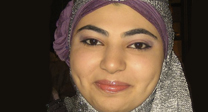Image Analysis
SCI's imaging work addresses fundamental questions in 2D and 3D image processing, including filtering, segmentation, surface reconstruction, and shape analysis. In low-level image processing, this effort has produce new nonparametric methods for modeling image statistics, which have resulted in better algorithms for denoising and reconstruction. Work with particle systems has led to new methods for visualizing and analyzing 3D surfaces. Our work in image processing also includes applications of advanced computing to 3D images, which has resulted in new parallel algorithms and real-time implementations on graphics processing units (GPUs). Application areas include medical image analysis, biological image processing, defense, environmental monitoring, and oil and gas.
Ross Whitaker
Segmentation
Chris Johnson
Diffusion Tensor AnalysisFunded Research Projects:
Publications in Image Analysis:
  Interactive Analysis for Large Volume Data from Fluorescence Microscopy at Cellular Precision Y. Wan, H.A. Holman, C. Hansen. In Computers & Graphics, Vol. 98, Pergamon, pp. 138-149. 2021. DOI: https://doi.org/10.1016/j.cag.2021.05.006 The main objective for understanding fluorescence microscopy data is to investigate and evaluate the fluorescent signal intensity distributions as well as their spatial relationships across multiple channels. The quantitative analysis of 3D fluorescence microscopy data needs interactive tools for researchers to select and focus on relevant biological structures. We developed an interactive tool based on volume visualization techniques and GPU computing for streamlining rapid data analysis. Our main contribution is the implementation of common data quantification functions on streamed volumes, providing interactive analyses on large data without lengthy preprocessing. Data segmentation and quantification are coupled with brushing and executed at an interactive speed. A large volume is partitioned into data bricks, and only user-selected structures are analyzed to constrain the computational load. We designed a framework to assemble a sequence of GPU programs to handle brick borders and stitch analysis results. Our tool was developed in collaboration with domain experts and has been used to identify cell types. We demonstrate a workflow to analyze cells in vestibular epithelia of transgenic mice. |
 Detection and segmentation in microscopy images, N. Ramesh, T. Tasdizen. In Computer Vision for Microscopy Image Analysis, Academic Press, pp. 43-71. 2021. DOI: 10.1016/B978-0-12-814972-0.00003-5 The plethora of heterogeneous data generated using modern microscopy imaging techniques eliminates the possibility of manual image analysis for biologists. Consequently, reliable and robust computerized techniques are critical to analyze microscopy data. Detection problems in microscopy images focuses on accurately identifying the objects of interest in an image that can be used to investigate hypotheses about developmental or pathological processes and can be indicative of prognosis in patients. Detection is also considered to be the preliminary step for solving subsequent problems, such as segmentation and tracking for various biological applications. Segmentation of the desired structures and regions in microscopy images require pixel-level labels to uniquely identify the individual structures and regions with contours for morphological and physiological analysis. Distributions of features extracted from the segmented regions can be used to compare normal versus disease or normal versus wild-type populations. Segmentation can be considered as a precursor for solving classification, reconstruction, and tracking problems in microscopy images. In this chapter, we discuss how the field of microscopic image analysis has progressed over the years, starting with traditional approaches and then followed by the study of learning algorithms. Because there is a lot of variability in microscopy data, it is essential to study learning algorithms that can adapt to these changes. We focus on deep learning approaches with convolutional neural networks (CNNs), as well as hierarchical methods for segmentation and detection in optical and electron microscopy images. Limitation of training data is one of the significant problems; hence, we explore solutions to learn better models with minimal user annotations. |
  Leveraging 31 Million Google Street View Images to Characterize Built Environments and Examine County Health Outcomes Q. C Nguyen, J. M. Keralis, P. Dwivedi, A. E. Ng, M. Javanmardi, S. Khanna, Y. Huang, K. D. Brunisholz, A. Kumar, T. Tasdizen. In Public Health Reports, Vol. 136, No. 2, SAGE Publications, pp. 201-211. 2021. DOI: doi.org/10.1177/0033354920968799 Objectives Methods
We leveraged computer vision and Google Street View images accessed from December 15, 2017, through July 17, 2018, to detect features of the built environment (presence of a crosswalk, non–single-family home, single-lane roads, and visible utility wires) for 2916 US counties. We used multivariate linear regression models to determine associations between features of the built environment and county-level health outcomes (prevalence of adult obesity, prevalence of diabetes, physical inactivity, frequent physical and mental distress, poor or fair self-rated health, and premature death [in years of potential life lost]).Results
Compared with counties with the least number of crosswalks, counties with the most crosswalks were associated with decreases of 1.3%, 2.7%, and 1.3% of adult obesity, physical inactivity, and fair or poor self-rated health, respectively, and 477 fewer years of potential life lost before age 75 (per 100 000 population). The presence of non–single-family homes was associated with lower levels of all health outcomes except for premature death. The presence of single-lane roads was associated with an increase in physical inactivity, frequent physical distress, and fair or poor self-rated health. Visible utility wires were associated with increases in adult obesity, diabetes, physical and mental distress, and fair or poor self-rated health.Conclusions
The use of computer vision and big data image sources makes possible national studies of the built environm
|
  Lessons learned towards the immediate delivery of massive aerial imagery to farmers and crop consultants A. A. Gooch, S. Petruzza, A. Gyulassy, G. Scorzelli, V. Pascucci, L. Rantham, W. Adcock, C. Coopmans. In Autonomous Air and Ground Sensing Systems for Agricultural Optimization and Phenotyping VI, Vol. 11747, International Society for Optics and Photonics, pp. 22 -- 34. 2021. DOI: 10.1117/12.2587694 In this paper, we document lessons learned from using ViSOAR Ag Explorer™ in the fields of Arkansas and Utah in the 2018-2020 growing seasons. Our insights come from creating software with fast reading and writing of 2D aerial image mosaics for platform-agnostic collaborative analytics and visualization. We currently enable stitching in the field on a laptop without the need for an internet connection. The full resolution result is then available for instant streaming visualization and analytics via Python scripting. While our software, ViSOAR Ag Explorer™ removes the time and labor software bottleneck in processing large aerial surveys, enabling a cost-effective process to deliver actionable information to farmers, we learned valuable lessons with regard to the acquisition, storage, viewing, analysis, and planning stages of aerial data surveys. Additionally, with the ultimate goal of stitching thousands of images in minutes on board a UAV at the time of data capture, we performed preliminary tests for on-board, real-time stitching and analysis on USU AggieAir sUAS using lightweight computational resources. This system is able to create a 2D map while flying and allow interactive exploration of the full resolution data as soon as the platform has landed or has access to a network. This capability further speeds up the assessment process on the field and opens opportunities for new real-time photogrammetry applications. Flying and imaging over 1500-2000 acres per week provides up-to-date maps that give crop consultants a much broader scope of the field in general as well as providing a better view into planting and field preparation than could be observed from field level. Ultimately, our software and hardware could provide a much better understanding of weed presence and intensity or lack thereof. |
 Determining uranium ore concentrates and their calcination products via image classification of multiple magnifications, C. Ly, C. Vachet, I. Schwerdt, E. Abbott, A. Brenkmann, L.W. McDonald, T. Tasdizen. In Journal of Nuclear Materials, 2020. Many tools, such as mass spectrometry, X-ray diffraction, X-ray fluorescence, ion chromatography, etc., are currently available to scientists investigating interdicted nuclear material. These tools provide an analysis of physical, chemical, or isotopic characteristics of the seized material to identify its origin. In this study, a novel technique that characterizes physical attributes is proposed to provide insight into the processing route of unknown uranium ore concentrates (UOCs) and their calcination products. In particular, this study focuses on the characteristics of the surface structure captured in scanning electron microscopy (SEM) images at different magnification levels. Twelve common commercial processing routes of UOCs and their calcination products are investigated. Multiple-input single-output (MISO) convolution neural networks (CNNs) are implemented to differentiate the processing routes. The proposed technique can determine the processing route of a given sample in under a second running on a graphics processing unit (GPU) with an accuracy of more than 95%. The accuracy and speed of this proposed technique enable nuclear scientists to provide the preliminary identification results of interdicted material in a short time period. Furthermore, this proposed technique uses a predetermined set of magnifications, which in turn eliminates the human bias in selecting the magnification during the image acquisition process. |
 Adversarial regression training for visualizing the progression of chronic obstructive pulmonary disease with chest x-rays, R.B. Lanfredi, J.D. Schroeder, C. Vachet, T. Tasdizen. In Arxiv, In International Conference on Medical Image Computing and Computer-Assisted Intervention, 2019. Knowledge of what spatial elements of medical images deep learning methods use as evidence is important for model interpretability, trustiness, and validation. There is a lack of such techniques for models in regression tasks. We propose a method, called visualization for regression with a generative adversarial network (VR-GAN), for formulating adversarial training specifically for datasets containing regression target values characterizing disease severity. We use a conditional generative adversarial network where the generator attempts to learn to shift the output of a regressor through creating disease effect maps that are added to the original images. Meanwhile, the regressor is trained to predict the original regression value for the modified images. A model trained with this technique learns to provide visualization for how the image would appear at different stages of the disease. We analyze our method in a dataset of chest x-rays associated with pulmonary function tests, used for diagnosing chronic obstructive pulmonary disease (COPD). For validation, we compute the difference of two registered x-rays of the same patient at different time points and correlate it to the generated disease effect map. The proposed method outperforms a technique based on classification and provides realistic-looking images, making modifications to images following what radiologists usually observe for this disease. Implementation code is available athttps://github.com/ricbl/vrgan. |
 Identifying surface morphological characteristics to differentiate between mixtures of U3O8 synthesized from ammonium diuranate and uranyl peroxide, S. T. Heffernan, N. Ly, B. J. Mower, C. Vachet, I. J. Schwerdt, T. Tasdizen, L. W. McDonald IV. In Radiochimica Acta, 2019. In the present study, surface morphological differences of mixtures of triuranium octoxide (U3O8), synthesized from uranyl peroxide (UO4) and ammonium diuranate (ADU), were investigated. The purity of each sample was verified using powder X-ray diffractometry (p-XRD), and scanning electron microscopy (SEM) images were collected to identify unique morphological features. The U3O8 from ADU and UO4 was found to be unique. Qualitatively, both particles have similar features being primarily circular in shape. Using the morphological analysis of materials (MAMA) software, particle shape and size were quantified. UO4 was found to produce U3O8 particles three times the area of those produced from ADU. With the starting morphologies quantified, U3O8 samples from ADU and UO4 were physically mixed in known quantities. SEM images were collected of the mixed samples, and the MAMA software was used to quantify particle attributes. As U3O8 particles from ADU were unique from UO4, the composition of the mixtures could be quantified using SEM imaging coupled with particle analysis. This provides a novel means of quantifying processing histories of mixtures of uranium oxides. Machine learning was also used to help further quantify characteristics in the image database through direct classification and particle segmentation using deep learning techniques based on Convolutional Neural Networks (CNN). It demonstrates that these techniques can distinguish the mixtures with high accuracy as well as showing significant differences in morphology between the mixtures. Results from this study demonstrate the power of quantitative morphological analysis for determining the processing history of nuclear materials. |







